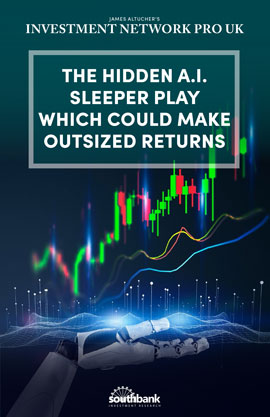Mad Monday and Trump’s market wrecking ball: two stocks to soar out of the fear
10th April 2025 |
It’s Tuesday morning, October 20, 1987. You walk down to the off-licence to grab the morning paper. Blazing across the headlines you see, A wipeout! Blood bath goes on in £60bn blow. The other papers aren’t much better, Shares: It’s Pure Panic, and The Great Wipeout!
You’d feel a pit in your stomach, your heartbeat quickening as dread permeates through your body. The stark reality sinks in, your investments are getting annihilated.


Black Monday, as it was labelled, installed “pure panic” in markets around the world, driving investors out of the market at all and any cost.
Investors watched helplessly as the Dow Jones Industrial Average haemorrhaged points, dropping a gut-wrenching 508 points in just a single trading session. To put this into context today, that’s the equivalent of today’s Dow losing around 8,000 points in a single session.
Why did it happen in 1987? Analysts blamed automated trading, portfolio insurance gone rogue, economic uncertainty, and fear-driven selling. Yet, at the heart of it all was one thing: raw, unadulterated panic.
Fear of losing everything clouded rational judgment, causing investors to indiscriminately dump even high-quality, fundamentally sound stocks alongside speculative holdings.
But here’s the irony—and what proved to be, the opportunity.
Beneath the wreckage of shattered confidence lay a goldmine for investors brave enough to look past the panic. The market’s collapse pulled down not just speculative bets but strong, growing, and profitable businesses that were suddenly priced at bargain-bin levels.
Imagine seeing names like Coca-Cola, General Electric, or Microsoft trading at prices you hadn’t seen in years, completely detached from their fundamental financial strength and earnings power.
Legendary investor Warren Buffett foretold this scenario in the Berkshire Hathaway annual shareholder letter in 1986. In it he wrote,
“[O]ccasional outbreaks of those two super-contagious diseases, fear and greed, will forever occur in the investment community. The timing of these epidemics will be unpredictable. And the market aberrations produced by them will be equally unpredictable, both as to duration and degree.
Therefore, we never try to anticipate the arrival or departure of either disease. Our goal is more modest: We simply attempt to be fearful when others are greedy and to be greedy only when others are fearful.”
With those principles in mind, history rewarded those who seized the opportunity when fear was the norm.
Within just two trading sessions, the Dow had recovered half of what it had lost that day. And within two years it was hitting new all-time highs.
For deep-value investors, Black Monday was the ultimate buying opportunity. Brief, but clearly obvious for those with the right mindset, and risk appetite.
The lesson from Black Monday and subsequent market crisis events tells us that you have but a fleeting moment of time to pull off a great stock market heist when things look apocalyptic.
And my take is that today, even with the massive rebound in the market yesterday, and the likelihood that volatility will remain the name of the game for a while still, now is one of the market’s great buying opportunities.
That said, it stands to reason to be adding companies that are:
- profitable,
- growing,
- on a long-term thematic investment idea that can carry them through this period and one or two others that may come at us in the next four years.
Here are two that meet those three criteria and have the potential to soar out of this market’s fear.
Two Mad Monday stocks to soar out of the fear
Stock #1: Aptiv PLC (NYSE: APTV)
Aptiv is a global technology company specializing in the design, development, and manufacturing of car components and systems that will take the automotive industry towards an autonomous, and absolute safety future.
Their speciality is in electrification, autonomous driving, and advanced safety systems.
I should add that the electrification of cars isn’t some wild green, Net Zero fantasy. Electric cars by nature have more power and torque, greater longevity, and make for more efficient economies of scale and distribution.
Aptiv’s origins trace back to 1994 when it was established as General Motors’ Automotive Components Group. In 1995, it was rebranded as Delphi Automotive Systems, becoming an independent entity in 1999.
Over the years, Delphi expanded its product portfolio and global presence, becoming a leading supplier of automotive technologies.
I have some first-hand knowledge of Delphi having spent time with the company at CES in 2017, exploring their self-driving car technologies, and going for a ride in one of their self-driving Audis.

That same year, the company underwent a significant transformation by spinning off its powertrain segment into a separate entity, Delphi Technologies, and rebranding the remaining business around autonomous systems, connectivity and communication and advanced driver-assistance systems (ADAS) as Aptiv PLC. And this has enabled Aptiv to further develop and innovate these core technologies of the future.
Aptiv has been involved in the development of self-driving technologies with major global car makers, such as their partnership with Hyundai to establish Motional, a venture focused on commercialising autonomous vehicles.
Key Markets and Products
Aptiv’s product offering and business structures are organised into two main segments (albeit they separate things out into three):
- Electrical Distribution Systems and Engineered Components Group: These segments, cover the whole electrical and engineering side of vehicle systems. So, think of the electrical architecture of vehicles, including wiring harnesses, connectors, cable management, communications and electrical centres. Think of the way in which power is transferred and distributed around a vehicle with reliability and consistency. These components are essential for power distribution and data transmission within vehicles, across both internal combustion engine vehicles and EVs to ensure that cars don’t break down and fail.
- Advanced Safety and User Experience (AS&UX): This segment focuses on advanced safety technologies, user experience systems, and software solutions. Products include ADAS, infotainment systems, and importantly autonomous driving technologies. Aptiv’s expertise in this area enables automakers to enhance vehicle safety, connectivity, and user interfaces.
Aptiv serves a large customer base, including major legacy auto makers like General Motors, Ford, Volkswagen, and BMW. The company has strong footholds in all of Europe, North America and Asia.
But it’s their moves into China that holds significant growth potential. Even with the geopolitical chaos right now, there’s no doubt in my mind, that China will be the dominant supplier of high-tech cars to the world.
Aptiv has a hand in this, with involvement in the development of self-driving tech like MAXIEYE, a Chinese “intelligent driving technology” company of which Aptiv is the largest shareholder in that company.
Right now, with stocks depressed, Aptiv looks to be riding a big long term thematic wave of autonomous cars and is trading at a value that makes them a great long-term play.
For the 2024 year, Aptiv reported revenue of $19.7 billion, with an improved margin of 12.0% up from 10.6% in the prior year, reflecting improved operational efficiency.
From that was a net profit of $1.7 billion. At a market cap of just $12.4 billion, that puts Aptiv’s price-to-earnings ratio at just 7.29x.
While the auto industry does tend to run at lower earnings than tech companies. Aptiv, I believe is more “tech” than “car” and that with the long-term theme of autonomous cars and the demand for the tech to make that happen, as a market leader in this space Aptiv is a great long-term stock to come out of this period of market fear.
Risks
There are still risks clearly with a stock like this. Namely the rollout of autonomous systems, and the technology risk that entails is significant.
The systems and platforms need to work and deliver the highest safety to meet global regulations and standards. Failure to achieve those benchmarks would be a drag on the stock price.
Also, this is a market with competition, and companies developing the vision, connectivity and “intelligence” of cars needed for a self-driving future will be a constant threat to the revenues and future profitability of Aptiv.
And of course, market risk. As we’ve seen where the stock price can go into freefall with the rest of the market there’s no guarantee we won’t see more of that in the coming weeks. So, while the stock looks attractively priced now, there may be future opportunity to accumulate at lower prices. And another major market correction lower will undoubtedly drag Aptiv down as well.
That said, it’s a great company, on a big long-term trend, with growth to come and that is financially stable amid market turmoil.
Buying Instructions
BUY Aptiv Plc (NYSE:APTV) current price $50.40. Buy up to $55.
Set a stop exit at $25.
52 week low/high: $47.78 / $85.56
Market Cap: $11.5B
Stock #2: Micron (NASDAQ:MU)
In every gold rush, there are dreamers and there are dealers. Most chase the headline prize: gold, oil, crypto, AI. But the smart money? It backs the infrastructure. The quiet enablers. The companies selling shovels while the mob scrambles for nuggets.
Micron is a shovel seller.
This time, the gold rush is artificial intelligence (AI). And Micron isn’t just selling shovels, arguably Micron is the entire transportation network that gets the prospectors to the gold fields.
The importance of Micron cannot be understated. They are as equally important to the roll out of AI in our world as Nvidia is. One does not work without the other. And for my mind, Micron might just be the single most exciting stock in the entire world right now after its recent market hammering.
The Forgotten Layer of AI
At its core, there’s nothing magical about AI. It’s just maths. Enormous, compute-hungry maths and data processing. And all that gigantic processing power from Nvidia, AMD and Intel is useless without memory.
Not just any memory though. High-bandwidth, high-capacity, high-speed, low latency, memory.
Micron is one of just three companies in the world that can produce the bleeding-edge memory AI models demand. That’s it. Three. It’s them, SK Hynix and Samsung Electronics.
And while Nvidia is worth $2.8 trillion with a price-to-earnings ratio of 39x and counting, Micron trades at $78 with a market cap of just $87 billion and a price-to-earnings ratio of just 18x.
That’s the opportunity.
HBM: Three Letters That Change Everything
High-Bandwidth Memory, or HBM, is the secret sauce behind modern AI performance. It feeds data to GPUs fast enough to keep them from sitting idle. HMB is the future of better AI.
Year on year Micron has seen HBM revenues increase for a factor of 19, with revenues crossing $1 billion for the first time. Furthermore, as they gain market share, they estimate the total addressable market of HBM to exceed $100 billion by 2030. And the expectation is they’ll at least have around 30% of that market.
That’s not hype, nor a typo, that’s real, explosive growth from Tier 1 customers.
Translation? The AI buildout is hitting escape velocity and Micron is squarely at the front of the line to profit.
I think the market is sleeping on Micron because they don’t understand the importance of memory that well, let alone the complexity and absolute necessity of HBM. GPUs are sexy, memory…not so much. And that flair I think works in the favour of Micron investors getting in now.
Still Cheap. For Now.
Micron is highly profitable and growing. Their trailing 12 months, shows $31.3 billion in revenues, and net income of $4.6 billion.
The acceleration of that growth is significant, and the continuation of that I don’t see slowing down for a considerable about of time, considering the speed at which AI compute is accelerating and demanding more and higher-bandwidth memory.
Micron is the leader in that and will continue to be the go-to company to deliver it.
The bottom line is that they’re cheap now because the heat has completely come out of AI stocks in 2025 so far, and then the recent tariff turmoil has smashed companies like Micron lower.
So low, that it’s a deep value stock.
It’s 52-week range tells the story. A high of $157.54 and a low of $61.54. Currently at $78, that tells you where things are at, but also how much room there is to run back to those highs, and what I expect to be even further over the long term.
Put it this way, I don’t see any reason why over the next decade, Micron doesn’t “do an Nvidia and soars in value to be worth $2 trillion-plus.
In that event from $87 billion today, you’d be looking at around a 23x gain on your capital invested today.
That’s the upside I think Micron has long term.
Risks
Clearly it comes with risk. And we’ve seen that play out in the last few months. This is a heavily thematically driven stock. AI is the theme, and slowing down of capital spend on AI infrastructure, or the loss of key customers, who are pulling back on AI spending will slow the revenue and profit growth of the company.
Earnings season may very well see heightened volatility as earnings expectations can be met, but if the roof isn’t blown off, then selling is likely.
I would expect a lot of short-term volatility, but ultimately this has to be a long-term play. Competition is there, and is fierce from SK Hynix and Samsung, but Micron is the leader. They must maintain their technology and competitive advantage with their HBM products to ensure they grow and keep market share.
With the market volatility still a present risk as well, do stick to the stop exits in the event of unpredictable events that could shock the whole market lower again.
Buying Instructions
BUY Micron (NASDAQ:MU) current price $70.10. Buy up to $77.
Set a stop exit at $40.
52 week low/high: $61.54 / $157.54
Market Cap: $78B
Buy List update
Solaría Energia Y Medio Ambiente SA (MA:SLR)
Solaria has only been in the buy list for a couple of months, but instantly the trade headed south. The stock has been in a persistent run lower, and with the current geopolitical situation, and what appears to be a complete reordering of global energy markets, we think the smart move is to exit here and now, before things get worse.
Action to take: SELL Solaría Energia Y Medio Ambiente SA (MA:SLR)
Prysmian SpA (LSE: 0NUXE)
Prysmian is another that looked for intents and purposes that it would continue its run higher through 2024, which it did, peaking in January this year. But it’s now ripped down to €40 from its €71 high. That’s taken it into a loss position for us, but not one so deep that it’s a portfolio killer. We think the move now is to step out of this position, as while it may have long term growth potential, the expectation that it can get back to those highs quickly, as opposed to over the next three or four years is unlikely.
Action to take SELL Prysmian SpA (LSE: 0NUXE)
Rolls Royce (LSE:RR)
Rolls Royce has been on an incredible run since the devastation of the company and stock during Covid. In fact, we recall when they undertook the right issue back in October 2020, at the insanely low price of just 32 pence.
That’s right, 32 pence.
At the time, we recommended that everyone eligible for the rights issue take it up in full. That the long-term potential of Rolls Royce was still intact, even though at the time the company was on shaky footing. Those rights issues, even after the mayhem in the market this week are up a brilliant 1,973%. If you took up the rights issue and still hold the stock, we’d love to hear if you made a sizeable gain from it – please write in to [email protected] if you’ve got a story to tell.
Anyway, for now the Rolls Royce position has been around for a long time. And we do sit on a 118% gain from the original recommendation. Considering all that’s passed in the last five years, that’s not bad.
Still, we don’t want to lose that win. We’re not selling out of Rolls Royce, but what we are doing now is lifting the stop exit on the position to 608.80 GBp. That means we’re locking in the 100% win on the original position (and of course 1,800% on the rights issue stock).
That’s really to protect the profit with so much geopolitical chaos right now. Rolls had been as high as 818 GBp a month ago, and we are aiming for it to return to that. But if the market shudders again, we want to protect a hard fought and won profit too.
Action to take: set a stop exit on Rolls Royce (LSE:RR) at 606.80 GBp.


